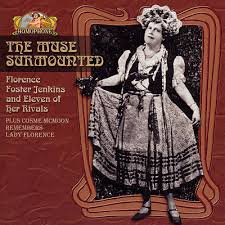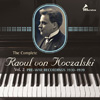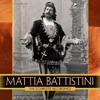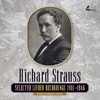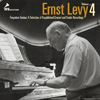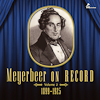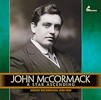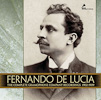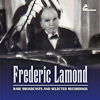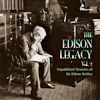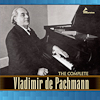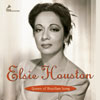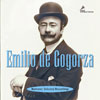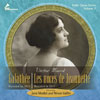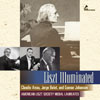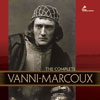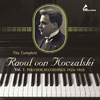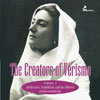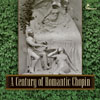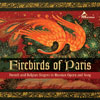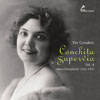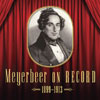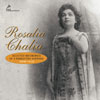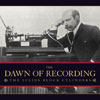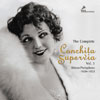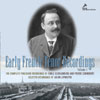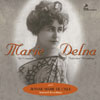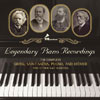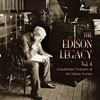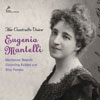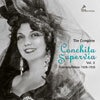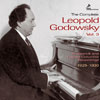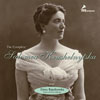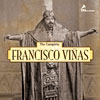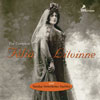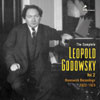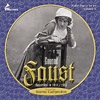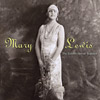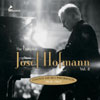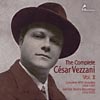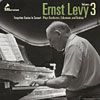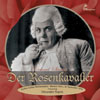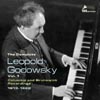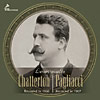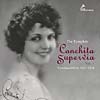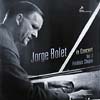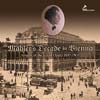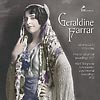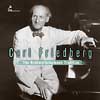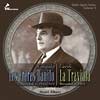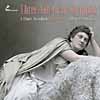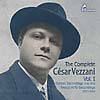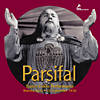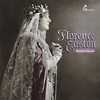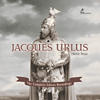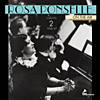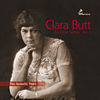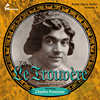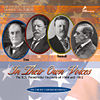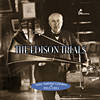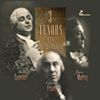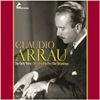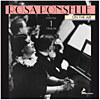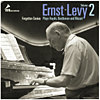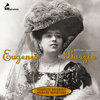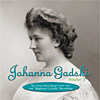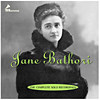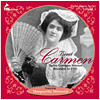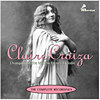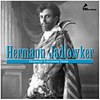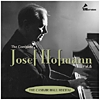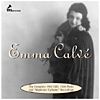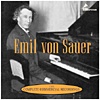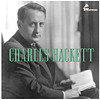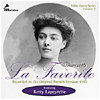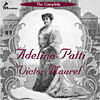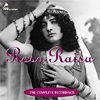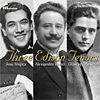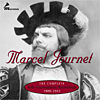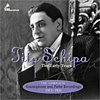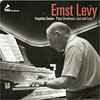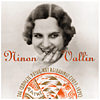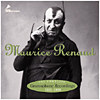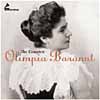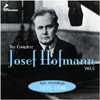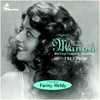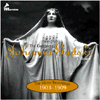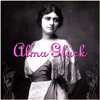
206 Cheshire Circle, West Chester, PA 19380 - 610.690.1703 [voice] - 610.328.6355 [fax]
info@marstonrecords.com [e-mail]
current catalogue
| The Muse Surmounted | ||
| There are singers who were so enthusiastic about their own singing that they believed they were great despite their lack of technique or musicianship. This is a compilation of recordings by singers such as Florence Foster Jenkins, Tryphosa Bates-Batcheller, Mari Lyn, and many others. Robert Levine in Classics Today said "This has to be heard to be believed, and believe me, it has to be heard ... This is priceless as a study in aberrant behavior, the history of opera, and sociology ..." Larry Holdridge in The Record Collector felt the singers contained in this compilation "...are demonstrating music from a different perspective. Theirs is simply the joy of performing without being restricted by the printed score and vocal technique ..." Rick Robertson for Amazon stated The Muse Surmounted "... is an uproariously funny excursion into what I would label 'mal canto'. Each singer in this collection set her own substandard for vocal art, and each one is presented in transfers that allow the holes in one's technique to shine through. Brightly.... This is also a first-class production, with attention to quality in presentation. The program notes alone are worth the price of the CD. Gregor Benko has carefully researched these singers, often waiting years for leads to information.... " (This is issued on the Homophone label.) | |
| The Complete Raoul von Koczalski vol. 2: Homochord, Electrola, and Polydor recordings, 1930-1939 | ||
| Raoul von Koczalski was born in 1885 and at the age of seven began studying with Chopin-student Karol Mikuli. The first impression of Koczalski’s playing is often one of the fluency and grace of his execution, coupled with his subtlety of phrasing and smooth legato, but what one is often left with is his use of rubato. This aspect of his playing has given rise to debate about Chopin’s musical intentions and has sparked both criticism and admiration of Koczalski’s playing; it will delight many and dissuade some, while asking all to consider if this is the definitive interpretation of Chopin. This three CD-set is the second and final volume of the complete pre-war recordings of this controversial pianist. It is almost entirely devoted to Chopin, including recordings of the complete etudes, preludes, and ballades. | |
| Mattia Battistini: The Complete Recordings | ||
| Mattia Battistini is unique among baritones. Battistini was born in 1856 and sang in the tradition of Tamburini, Ronconi, and Cotogni. Due to an exceedingly long career the zenith of which coincided with the invention of the gramophone, we can enjoy a rare glimpse into a bygone era of baritone-singing, especially since Battistini was still singing beautifully well into his sixties. To round off this six CD set, Marston will add eleven Fonotipia sides from 1910-1911 of baritone Giuseppe Bellantoni (1880 - 1946). Bellantoni is a “modern” singer who overlaps Battistini on the musical timeline. Pairing these two baritones on one CD set provides the contrast needed to paint a more complete history of baritone singing on record. | |
| Jorge Bolet, Volume 2 Ambassador from the Golden Age: A Connoisseur's Selection for the Bolet Centennial | ||
| Arthur Rubinstein, during a visit to the Curtis Institute of Music in 1938, singled out just one young artist who was likely to achieve a major career, the twenty-four-year-old Cuban pianist Jorge Bolet, who already (like Rubinstein) had an inimitably beautiful piano tone. The confirmation of Rubinstein’s prediction, however, was to be many decades in coming. Bolet (arguably similar to Rubinstein) had a narrative power and visceral excitement when playing before an audience that he seldom achieved in the recording studio. To celebrate Bolet’s centennial, Marston presents this six-CD collection of concert performances, many of which are all new to the Bolet discography. Jorge Bolet was not the only pianist to have been called “the last romantic,” but he was the only one to have worn the appellation “an old-fashioned Romantic pianist” as a proud badge of honor. He frequently invoked the memories of the pantheon of pianists who were his inspiration—Hofmann, Rachmaninoff, Friedman, Rosenthal, Moiseiwitsch, Cortot, Gieseking, and Paderewski. He said simply, “I wanted to be one of them.” Here is a collection to prove he achieved just that. Although more than seven hours of Bolet playing, the recordings contained on this set are carefully-selected to highlight Jorge Bolet at his spontaneous best. Included are a number of Godowsky compositions that Jorge never recorded commercially; two selections from the 1970 International Piano Library benefit concert; and several pieces that are unique to the Bolet discography such as the Bach Toccata, the Mozart Rondo, the Chasins Schwanda Fantasy, and the Vořišek Impromptu in E. | |
| Richard Strauss: Selected Lieder Recordings 1901-1946 | ||
| Richard Strauss’s (1864–1949) acceptance into the pantheon of great Lieder composers began in the early 1950s, perhaps marked by the enthusiastic reception of his Four Last Songs, premiered by Kirsten Flagstad eight months after Strauss’s death. It wasn’t long before these songs became widely performed, and by extension, his Lieder as a whole, began to gain greater acceptance as high art along with Schubert, Schumann, Brahms, and Wolf. This compilation concentrates on Strauss Lieder recordings from an earlier era that display the sort of vocal charm and straightforward approach to the music not usually heard in today’s style of Lieder singing. Many of these recordings are extremely important historic documents retaining their position as the definitive versions of Strauss Lieder. Some of the singers included here not only knew Strauss, but worked with him, and their recordings could have been heard and judged by him. This three CD-set contains forty songs in eighty-two performances by fifty-seven singers. | |
| Ernst Levy, Vol. 4 Forgotten Genius: A Selection of Unpublished Concert and Studio Recordings | ||
| When Marston began the Ernst Levy series early in the company's history, few knew this remarkable pianist and many were stunned by his artistry and deep insight into the music of Beethoven and Liszt. The series developed into a mission not only to uncover and make available additional Levy performances, but also to expand the accepted perceptions of some of the most important works in the piano repertoire. This fourth installment will not disappoint. It comprises concert and studio recordings of Haydn, Schubert, Franck, Beethoven, Brahms, and Liszt, including a virtually unknown performance of the Schubert Posthumous Sonata in A and a previously unreleased 1959 stereo-recorded performance of Liszt's B Minor Ballade. | |
| Meyerbeer On Record, Volume 2 1899-1925 | ||
| Giacomo Meyerbeer was one of the greatest composers of his time, though his operas have virtually disappeared from the repertory. There are several possible explanations. It is postulated that Meyerbeer’s tradition of grand opéra fell out of favor. With the rise of verismo, there was a move away from the heroic tradition and a decline in the art of bel canto singing required for the proper rendition of his roles. Negative attitudes toward Meyerbeer are an aspect of this negativity toward bel canto in general, which emerged in the third part of the 19th century. This pro-German movement, focused on Richard Wagner, became entrenched in academic circles, with enduring effects. It has also been proposed that the adoration of Wagner, whose rise coincided with Meyerbeer’s fall, helped push Meyerbeer into obscurity; it is cited that a climate of anti-Semitism (fanned by Wagner and promoted by National Socialism) accelerated Meyerbeer’s eclipse. It has also been less convincingly observed that there are nearly insurmountable obstacles needed to produce a Meyerbeer opera today, and this leaves his works languishing. For whatever the reason, one must depend on recordings to understand the greatness that is Giacomo Meyerbeer. Meyerbeer on Record, volume 2 chronicles his last three operas: L’ÉTOILE DU NORD, LE PARDON DE PLOËRMEL (also known as DINORAH), and L’AFRICAINE. Every effort has been made to provide the definitive recorded example of all sung portions of these operas, giving preference to those excerpts performed in Meyerbeer’s chosen language of French and recorded by some of the greatest voices of our musical past. In addition to three discs is a booklet containing biographies and rare photographs of the singers; plot summaries of the operas; and essays by highly respected Meyerbeer scholars. For the present, this set is one of the few ways to experience Meyerbeer, though it is hoped that this will be a bridge leading to the time when his enthralling operas will be performed again. "This set is beautifully presented and is accompanied by what is one of the most lavish and beautifully produced booklets ever to accompany any issue of recorded music." -Stanley Henig, Classical Recordings Quarterly, Autumn 2014 | |
| John McCormack, A Star Ascending Odeon Recordings: 1906-1909 | ||
| John McCormack (1884–1945) is still remembered and revered by many today. The natural beauty of his voice, allied with his phenomenal technique, unequaled breath control, and eloquence of sentiment, lead many to regard him as the world’s supreme lyric tenor. This four-CD set includes operatic arias, Irish ballads, and popular songs from McCormack’s Odeon recordings dating from 1906–1909, as well as nine cylinder recordings of 1906 made for the Edison Bell and Russell Hunting companies. These early recordings are sometimes dismissed by admirers of McCormack and collectors of vocal art because they do not capture him at his artistic zenith. They are, however, almost unique in the history of the gramophone as they allow us to trace McCormack’s steady development, session by session, from his uneven, raw, and sometimes undistinguished singing in 1906 to performances showing him on the cusp of mastery by 1909. "With comprehensive documentation and a selection of equally well-transferred cylinder recordings, this must be counted as one of the major historic CD releases of the last decade." -Gramophone, July 2014 | |
| Fernando De Lucia: The Complete Gramophone Company Recordings 1902-1909 | ||
| Fernando De Lucia (1860 - 1925) is one of the most well-known tenors on early records. His recording career spanned 18 years and yielded some 300 sides. Although De Lucia portrayed a number of important verismo roles, his vocal technique was solidly grounded in the pre-verismo style. Therefore today, De Lucia is viewed as one of the most important links to the graceful and ornamental style of singing prior to verismo. His early recordings, which appear in this compilation, many of which are rare and highly sought-after, present a broad range of roles both bel canto and verismo. Although other historic labels have documented De Lucia's recordings, this release will provide new insight into De Lucia's recorded legacy by transcribing his records at play back speeds that Ward Marston is convinced are correct, yet remain controversial. The set will conclude with an ample selection of De Lucia's later recordings for the Phonotype label, which reflect his important operatic roles that were not represented on his Gramophone Company discs. | |
| Frederic Lamond: Rare Broadcasts and Selected Recordings | ||
| Frederic Lamond was born in Glasgow in 1868. As a teenager, he studied with Hans von Bülow; had lessons with Liszt at Weimar and Rome; was coached by Brahms; and was greatly influenced by Anton Rubinstein, with whom he was well acquainted. In addition to being an early champion of Brahms, Lamond is considered an authority on Beethoven's piano music and is a member of that small circle of Liszt pupils who had the opportunity to make records. This two-CD set includes two concerto broadcasts, never before available, and his acoustic recordings of Beethoven sonatas issued here for the first time on CD. The set also includes a fascinating spoken reminiscence by Lamond about Liszt. | |
| The Complete Arthur Endrèze | ||
| Arthur Endres Kraeckmann was born in Chicago on 28 November 1893. He won a scholarship to study at the American Conservatory in Fontainbleau for the summer of 1921, yet Kraeckmann remained in France. He studied with no less than Jean De Reszke and Reynaldo Hahn, and established himself (under the name of Arthur Endrèze) as one of the great "French" baritones. Endrèze rarely visited the United States, and his career was almost entirely in France. Endrèze returned to Chicago in 1974, where he died less than a year later. The recorded output of Arthur Endrèze is historically important and has never been issued in its entirety. Endrèze is firmly footed in the French style of singing, an art that is lost today. | |
| The Edison Legacy Volume 2: Unpublished Treasures of the Edison Archive | ||
| This three CD set marks the next installment of the historically significant release of unpublished Edison diamond disc masters. Thomas Edison, inventor of the phonograph, began his own recording company in 1898, and for the next 14 years, he released only wax cylinder recordings, while by 1905, most other companies were using the more practical flat disc format. By 1909, the cylinder was a dying medium, and Edison realized that his company needed to compete in the disc market. Consequently, he strove to produce a better-sounding disc than any of his competitors. For nearly three years, he made disc recordings before publishing any. Over a hundred of these wax disc masters still exist in the Edison archive, unheard by anyone until now. These recordings contain not only some very fine singing, but also, some of the best sound to be heard on acoustic recording. This volume contains three recordings by the renowned baritone, Giussepe Kaschmann; tenor Umberto Macnez; contralto Marie Delna; sopranos Adelina Agostinelli, Celestina Boninsegna, Carolina White, Maria Galvany, and a marvelous duet from Verdi's Otello with Marie Rappold and Leo Slezak. | |
| The Complete Vladimir de Pachmann | ||
| Vladimir de Pachmann (1848-1933), the most controversial of the few pianists alive during Chopin's lifetime who also left recordings, studied piano at the Vienna Conservatory with Joseph Dachs and theory with Bruckner, making his debut in 1869. Soon he heard Tausig, von Bülow, and Rubinstein, stopped performing entirely and locked himself up to practice compulsively. When he emerged ten years later his playing had features of all three, plus a uniquely smooth, pearly quality. He began to appear in public again in 1882, just about the time when he met Liszt, whose personality and playing became the greatest influence in his life. Always high-strung, he gradually discovered that if he talked to his audiences, his stage fright lessened. The public adored his Chopin, which frustrated him, for he wanted to play Beethoven also. Within a few years he gave in to public demand and became the number one Chopin specialist of all time. Concurrently his platform behavior evolved into a kind of show, with grimaces, muttered asides, and boasts. As well known for his eccentricities as for his Chopin, the American critic James Huneker dubbed him "The Chopinzee," and the sobriquet stuck. Pachmann was the first internationally famous pianist to record commercially, making many records of varying quality over two decades starting with 1907 G and Ts. He was quoted saying any of his records were not "One percent of de Pachmann," although at the end he realized that glimmers of his art would live through them. A few of his worst records became his biggest sellers, for on them he talks during his playing. But many of his lesser-known recordings are among the greatest ever, unique, for his pianistic style harks back to the Hummel school. Knowing only his worst records, critics have dismissed him, but on his best records one can hear some of the finest piano playing ever recorded. De Pachmann-biographer Edward Blickstein contributes the liner notes. | |
| Elsie Houston: Queen of Brazilian Song | ||
| We are tremendously excited to be issuing the first comprehensive CD of the incomparable Brazilian mezzo-soprano, Elsie Houston. Her vocal production and interpretations defy description. The intensity of her passion coupled with the raw energy of her expression make Elsie Houston impossible to forget once you have heard any one of her records. She is undoubtedly the most individual of any classically trained singer to have recorded. Having studied singing with Lilli Lehmann and Ninon Vallin, Houston took her voice and career in a completely different direction, devoting the rest of her life to the performance of Brazilian music. Her first recording, made in Paris in 1927, contained four songs by Heitor Villa-Lobos with the composer's wife accompanying her at the piano. Also among her first records was a group of Brazilian folk songs that she collected and published. These are sung to the accompaniment of guitar, clarinet, and various indigenous percussion instruments. She made many night club appearances in Paris and later in the U.S. where exoticism of things South American had become the rage. | |
| Emilio de Gogorza: Baritone: Selected Recordings | ||
| Emilio de Gogorza was born in Brooklyn, New York, in 1874 of Spanish parents. He began his singing studies in Spain and sang in many languages including French, Italian, Spanish, and English. Owing to severe myopia, de Gogorza did not appear on the operatic stage, though he did have a major career as a concert singer. In fact, he made his debut in a concert with Marcella Sembrich in 1897. He lived and taught in New York, as well as in Philadelphia, where he taught at the Curtis Institute of Music. He was married for a time to soprano, Emma Eames, and although their marriage did not last, they remained life-long friends. Being one of the most prolific recording artists of his time, his many records have placed de Gogorza firmly in the pantheon of first ranking baritones. He used his voice skillfully and his impeccable diction made him especially well-suited to the acoustic recording process. This best of de Gogorza compilation will cover his recording career from 1900 to 1928, including several brown wax Edison cylinders issued under the name Senior Francisco. The set will conclude with the record which de Gogorza considered his personal favorite, Debussy's Voici que le Printemps recorded in 1928. | |
| Pathé Opera Series vol. 7: Victor Massé's Galathée and Les noces de Jeannette | ||
| Marston continues its Pathé opera series with the release of Victor Massé’s Galathée and Les noces de Jeannette. These recordings transport us back to an era when the true French style of singing still flourished in Paris. Galathée was recorded in 1912 and featured André Gresse, Alex Jouvin, Albert Vaguet, and Jane Morlet. Émile Archainbaud conducts. Les noces de Jeannette was recorded in 1922. This recording, conducted by Laurent Halet, features the incomparable Ninon Vallin as Jeannette, and the great comic baritone Léon Ponzio as Jean. To round out this three CD set we are including important Massé interpretations by Georgette Bréjean-Silver, Suzanne Brohly, Rose Heilbronner, and others. | |
| Liszt Illuminated Claudio Arrau, Jorge Bolet, and Gunnar Johansen American Liszt Society Laureates | ||
| It is with great pride and pleasure that the American Liszt Society sponsors the release of this 2 CD set on the occasion of the bicentennial of the birth of Franz Liszt. This compilation preserves contributions of three pianists (all American Liszt Society medal winners) to the performance legacy of the compositions and transcriptions of Liszt. Claudio Arrau, Jorge Bolet, and Gunnar Johansen each provide a unique perspective on Liszt's genius. Insightful notes are provided by Frank Cooper, Research Professor of Musicology at the University of Miami. In addition, personal recollections of their respective teachers are provided by Ira Levin, Gordon Rumson, and Garrick Ohlsson. | |
| The Complete Vanni-Marcoux | ||
| Vanni-Marcoux’s (1877 – 1962) career in opera roughly-spanned the first half of the last century. Marcoux made his debut as Wagner in Gounod's Faust in Bayonne in 1900; was a guest at Covent Garden every year between 1905 and 1912; created the roles of Guido Colonna (Monna Vanna) and Panurge; performed with the Boston Opera, Chicago Opera, the Colón, and La Scala; appeared in film; and ended his career as the director of the Opera in Bordeaux. His recording career began late (1924), yet Marcoux made approximately 120 sides, leaving a legacy that is well-loved by many and is highly sought-after. His voice is rich and expressive and his diction is near perfect, which alludes to his reputation as a great actor. This compilation is the first complete Vanni-Marcoux and the 6 CD-set will be offered at a substantial discount due to the generosity of our sponsor Fabrice Pilato. | |
| The Complete Raoul von Koczalski vol. 1 Polydor Recordings 1924-1928 | ||
| Today, the name “Koczalski” is not as well-known as other pianists of his era, yet his credentials, and more importantly his recordings, should garner better recognition. Raoul von Koczalski was born in 1885, and before he was six years old he caught the attention of Anton Rubinstein and music critic Edward Hanslick. At six, he was a pupil of Liszt-student Ludwig Marek and was studying composition with Henryk Jarecki. At the age of seven, Koczalski’s life was changed; he began studying with Chopin-student Karol Mikuli. This relationship defined Koczalski’s musical destiny as a pre-eminent interpreter of Chopin. The first impression of Koczalski’s playing is often one of the fluency and grace of his execution, coupled with his subtlety of phrasing and smooth legato, but what one is often left with is his use of rubato. This aspect of his playing has given rise to debate about Chopin’s musical intentions and has sparked both criticism and admiration of Koczalski’s playing; it will delight many and dissuade some, while asking all to consider if this is the definitive interpretation of Chopin. This two CD-set is the first volume of the important, and somewhat controversial, complete Raoul von Koczalski pre-war recordings. The second volume will contain his recordings from 1930-1939. | |
| The Creators of Verismo vol. 1 Bellincioni, Pandolfini, and the Siberia creator-recordings | ||
| Verismo opera is easier to identify than define. When one thinks of verismo, a number of composers come to mind: Mascagni, Leoncavallo, Puccini, Franchetti, and Giordano. During the first decade of the verismo era, several sopranos made their reputations in connection with this new kind of opera. Among them were Angelica Pandolfini, Gemma Bellincioni, Amelia Pinto, Rosina Storchio, and Emma Carelli, all of whom made recordings at the beginning of the 20th century. For the first time on CD, we will present the five incredibly rare G&T sides of Pandolfini, her complete recorded output, and the complete recordings of Gemma Bellincioni on four G&T sides, and ten Pathé sides. Also included in this set are the nine G&T sides from Giordano’s Siberia sung by the original cast. To round out this fascinating album with notes by Michael Aspinall, we will present selected recordings by other important La Scala sopranos of the period – Amelia Pinto, Emma Carelli, and Cesira Ferrani. These have all been transferred directly from original discs belonging to the collection of Mr. and Mrs. Laurence C. Witten II in the Yale Collection of Historical Sound Recordings at Yale University Library, and from several important private collections. | |
| A Century of Romantic Chopin | ||
| A Century of Romantic Chopin is a four CD-compilation commemorating the Chopin bicentennial year. The set will include some 65 pianists, going back to Francis Planté and Vladimir de Pachmann who were born when Chopin was still alive. Other pianists in the set include Josef Hofmann, Sergei Rachmaninoff, Ferruccio Busoni, Moritz Rosenthal, Ignace Jan Paderewski, Ignaz Friedman, Alfred Cortot, Jan Smeterlin, Rosita Renard, Claudio Arrau, Guiomar Novaes, Benno Moiseiwitsch, Solomon, Arthur Rubinstein, Emil Gilels, Earl Wild, Jorge Bolet, and others. All of Chopin’s etudes will be represented, as well as a selection of preludes, mazurkas, waltzes, nocturnes, ballades, and scherzi, each performance conveying a personal approach to the music. Some of the recordings will already be familiar to pianophiles because of their legendary status, while many others will be delightful surprises, as they are taken from concert performances and out-of-print recordings. | |
| Firebirds of Paris | ||
| In 1907, Sergei Diaghilev changed the musical landscape of Europe by introducing Russian music to Paris. Diaghilev’s Cinq Concerts Historique Russes (Five Historic Russian Concerts) was a remarkable cultural experience that left Paris hungering for Russian arts. He introduced Paris to Mussorgsky, Borodin, Rimsky-Korsakov, Balakirev, Scriabin, and Rachmaninoff. As with many newly-introduced art forms, the French wanted to make Russian music their own. In a relatively short time, many of the greatest French-language singers were performing Russian repertoire in French. Firebirds of Paris is a single CD devoted to these artists such as Vanni-Marcoux, André D’Arkor, Ninon Vallin, and Georges Thill. The set also includes many rare recordings of some lesser-known, though accomplished artists. The concept of Firebirds in Paris was first presented as a program for the Vocal Record Collectors’ Society in 1999 by Lewis Morris Hall, the producer of this compilation. | |
| The Complete Conchita Supervia: vol. 4 | ||
| Conchita Supervia is one of the most sought-after singers among serious record collectors. In fact, she is as close to a cult-figure as it gets with the shellac-set. Supervia recorded over 200 sides for Odeon and later, several sides for Ultraphone. Although many of these records are common, many were only issued in Spain and are extremely scarce. What makes Supervia so well loved is the unique timbre of her voice that is immediately recognizable. Whether singing La cenerentola, Carmen, or the vast number of unusual Spanish songs, Conchita Supervia is amazing. This two-CD set, the fourth in the Supervia series, spans 1932-1933 and includes some beautifully-executed Spanish songs on Odeon as well as her French-language version of Lehár’s Frasquita on Ultraphone. Finally, a previously undiscovered French Odeon record from 1930 is included, which is of two Eduardo Toldrá songs. | |
| Meyerbeer on Record 1899-1913 | ||
| Giacomo Meyerbeer was one of the most important composers in Paris during the mid-1800s. He is considered the founder of the French Grand Opera and his works dominated the French stage. Meyerbeer changed the face of opera in Paris, and yet, much criticism is directed toward him and much of his music is seldom heard today. This 3-CD set is the first of two volumes, which together will honor Meyerbeer and reacquaint the listener with his marvelous music and some very interesting singing. These two volumes will contain at least one version of every recorded Meyerbeer excerpt sung by French singers. They include cylinders and discs from the earliest days of recorded sound and continue through the 1930s. This compilation is not only an interesting way of organizing important and lovely French singing but gives a rare and extensive look into this style of singing. Volume one will feature recordings from Meyerbeer's first three operas written for Paris: Robert Le Diable, Les Huguenots, and Le Prophète. | |
| Rosalia Chalia: Selected Recordings of a Forgotten Soprano | ||
| Rosalia Chalia was born into Cuban nobility in 1866 and despite her family's wishes, she mounted a tremendously successful stage career. She was especially known for her Santuzza, which she sang at the Metropolitan Opera in the 1898 - 1899 Season. But possibly her greatest mark will be her role as the first major operatic star to make a series of disc recordings: the Eldridge R. Johnson Improved Record (Victor) in 1900 - 1901. She also sang for Bettini, Zonophone, and Columbia. Her records are rare and hard to find in good condition. Her voice is extremely flexible with a huge range and supple timbre. She negotiates coloratura passages with breathtaking agility and beauty. Her recordings are spellbinding and each one is a treasure. | |
| The Dawn of Recording: The Julius Block Cylinders | ||
| Starting in 1889, what is now recognized as one of the earliest dates to record music, Julius Block recorded some of the most important artists and personalities of his time on cylinder. His cylinders range in date from 1889 to 1927, and were recorded in Russia, Germany, and Switzerland. Our three-CD set includes artists who have previously remained "silent" and will change the conception of many artists whose discography up until now were thought to be complete. These are the only known recordings of Anton Arensky, Paul Pabst, Sergei Taneyev, Leo Conus, Jules Conus, Anna Essipova, Jan Hrimaly, Anatoly Brandukov, Elizaveta Lavrovskaya, and Paul Juon. These are also the earliest surviving recordings of Josef Hofmann, Nikolai Figner, Eddy Brown, and Egon Petri. There are also recordings of the 11-year-old Heifetz one week after his sensational debut with Arthur Nikisch and the Berlin Philharmonic, which adds four pieces to Heifetz's discography. And, they include the first recorded performances of Bach, Chopin, Mendelssohn, Schumann, Tchaikovsky, Wagner, Donizetti, Verdi, Bizet, and Arensky. | |
| The Complete Conchita Supervia: vol. 3 | ||
| Conchita Supervia is one of the most sought-after singers among the serious record collectors. In fact, she is as close to a cult-figure as it gets with the shellac-set. Supervia recorded over 200 sides for Odeon and later, several sides for Ultraphone. Although many of these records are common, many were only issued in Spain and are extremely scarce. What makes Supervia so well liked is the unique timbre of her voice that is immediately recognizable. Whether singing La cenerentola, Carmen, or the vast number of unusual Spanish songs, Conchita Supervia is amazing. This two-CD set, the third of five volumes, will span from 1930-1932 and will include her French language recordings from Carmen, an unpublised recording of "Air des larmes" from Werther, as well as her six Parlophone recordings of English songs. | |
| Early French Tenors: Émile Scaramberg, Pierre Cornubert, and Julien Leprestre | ||
| This release is the first of three double CD sets highlighting early French Tenors. Some of the artists included in these compilations will be well-known names to collectors, and others more obscure. Yet, all deserve a place in history. Émile Scaramberg, Pierre Cornubert, and Julien Leprestre will be featured in this first volume. Émile Scaramberg (1863–1938) an important singer, first at the Opéra-Comique and later at the Opéra, sang the French repertoire and Wagnerian roles with equal expertise and elegance. His complete recordings, made for Fonotipia between 1905–1906, are presented in this volume. Pierre Cornubert (1863–1922) and Julien Leprestre (1864–1909) are both less-well known today than Scaramberg, perhaps because of the scarcity of their records. Cornubert debuted at the Opéra-Comique in 1887 but sang primarily in houses such as Rouen, Marseilles, and Montpellier. He recorded eight sides for Fonotipia, five sides for Disque Ultima, and two Edison cylinders, all of which will be included here. Juliene Leprestre made his debut at Rouen in 1890 and subsequently appeared at La Monnaie. At the Opéra-Comique, he participated in several premiers and created the role of Jean Gaussin in Massenet’s Sapho. He recorded a few extremely rare discs for French Odeon in 1905–1907, a selection of which will be included in this volume. | |
| The Complete Recordings of Marie Delna and Selected Recordings of Jeanne Marié De’Lisle | ||
| At the turn of the last century, two of the greatest contraltos were Marie Delna and Jean Marié De’Lisle. Delna (1875-1932) had an expressive and striking voice with an immediacy and intensity that has rarely been duplicated. She debuted as Dido in Berlioz’s Les Troyens, she took part in the Paris premieres of Bruneau’s L’Attaque du Moulin and Massenet’s Werther, and premiered Godard’s La Vivandière. She recorded for Pathé and Edison (the latter more flattering to her voice). Jean Marié De’Lisle (1872-1926) recorded for G&T and Odeon between 1904 and 1906 resulting in nearly 100 records, many of which are lost today. She studied with her aunt Célestine Galli-Marié (the creator of Carmen and Mignon) and made her debut at the Opéra-Comique in 1896. Marié De’Lisle sang in the world premiere of Charpentier’s Louise, had a huge success as Charlotte in Massenet’s Werther, and succeeded her aunt as one of the great Carmens at the Opéra-Comique. | |
| Legendary Piano Recordings The Complete Grieg, Saint-Saëns, Pugno, and Diémer | ||
| In 1903, the Paris branch of the Gramophone and Typewriter Company made 27 incredibly important piano records. These documented the pianism of Edvard Grieg (1843–1907) and Raoul Pugno (1852–1914). The Grieg and Pugno recordings are some of the most rare and sought after discs and are unfortunately some of the most primitive and problematic. We are pleased to say that very recent technology has allowed us to greatly reduce these problems to produce these recordings in startlingly improved versions. This set also includes the equally rare 1904 G&T sides (five in total) of Camille Saint-Saëns (1835–1921) playing various selections from his own works, the eight sides Saint-Saëns recorded for the Gramophone Company in 1919, and other important piano recordings made by G&T. | |
| The Edison Legacy vol. 1 Hidden Treasures of the Edison Archive | ||
| It is not an exaggeration that the Edison Legacy series will be one of the most significant historical releases ever. Thomas Edison invented the phonograph in the last quarter of the 19th Century. He began recording artists in the late 1800s and by 1929 his record company was out of business. In this short period of time, he captured some of the greatest voices of the dawn of the recording era and yet, many of the recordings have never been published and have only been heard by Edison and his staff. These historic documents are some of the rarest and most important recordings in the world. The first volume of our series contains selections of Leisner, Melis, Bori, Walker, White, Korsoff, Olitzka, Destinn, and many other important singers of the last century. | |
| The Complete Eugenia Mantelli | ||
| Italian mezzo-soprano Eugenia Mantelli (1860–1926) made her debut in 1883 as Urbain in Les Huguenots at the Teatro São Carlos in Lisbon. She made long guest appearance tours in Germany, Italy, and South America with the famous Spanish tenor Julien Gayarré. She appeared at the Metropolitan Opera for six seasons (1894–1900) and sang again at the Met for the 1902–1903 season. She retired to Lisbon. Her repertoire was extraordinarily diverse, singing coloratura-contralto parts to that of Brünnhilde. She recorded for the American Zonophone label and her recordings are among the most sought after in the world. | |
| The Complete Conchita Supervia vol. 2 | ||
| Conchita Supervia is one of the most sought-after singers among serious record collectors. Supervia recorded over 200 sides for Fontipia/Odeon and a few sides for Ultraphone. Although many of her recordings are common, many were only issued in Spain and are extremely scarce. What makes Conchita Supervia so well liked is the unique timbre of her voice that is immediately recognizable. Whether singing La Cenerentola, Carmen, or the vast number of unusual Catalan songs, Conchita Supervia’s inimitable style and personality are always evident. This two-CD set, the second of five volumes, contains her recordings dating from 1929 to 1930. | |
| The Complete Leopold Godowsky vol. 3 | ||
| Leopold Godowsky (1870–1938) was one of the great geniuses in the history of piano, earning the highest esteem as both performer and composer. Virtually self-taught, he concertized all over the world until felled by a stroke during a London recording session in 1930. Godowsky was praised for his effortless technique and the remarkable tonal subtlety of his playing. Godowsky’s recorded legacy extends from 1913 to 1930 and includes discs made for both American and British Columbia as well as for Brunswick. Marston is proud to announce the third and final volume of this series. This 3 CD set, which includes the remaining Brunswick recordings and English Columbias, is priced as a 2 CD set. | |
| The Complete Salomea Krushelnytska | ||
| Salomea Krushelnytska (1872–1952) simply has one of the most beautiful dramatic soprano voices on record. The voice has strength and a dusky tone coupled with a mastery of phrasing. She had a remarkable career. It was rumored Krushelnytska could learn a part of a new opera in two days, and develop the character of a role in another three or four. In 1902 she won the hearts of Parisians in Lohengrin. In 1906 she enchanted the audience at Milan’s La Scala in Richard Strauss’s Salome conducted by Arturo Toscanini. Her rendition of the title role of the Brescia Madama Butterfly in 1904 contributed to Butterfly’s admission to the world repertoire. In addition, she created the role of Salome at La Scala’s premiere in 1907 as well as the role of Elektra in 1909. She also sang at the world premiere of Romani’s Fedra (1915). She was to settle in Milan, yet a visit to her birthplace, Lvov, in 1939 precluded her return to Italy. She taught at the conservatory in Lvov, where she had begun her illustrious career. This two CD set is complete, including her rare G & Ts, Fonotipias, and four electrical Columbias. | |
| The Complete Francisco Viñas | ||
| Viñas possessed a powerful, heroic-tenor voice that was beautifully focused with great warmth, which made him well suited for a wide range of roles including Wagner in Italian. Viñas (1863–1933) began his studies at the Conservatory in Barcelona, where he made his debut in 1888. He quickly rose to great success in Italy and soon was engaged at opera houses around the world. He was especially loved at La Scala and was a popular member of the Metropolitan Opera from 1893–1897. This three CD set is the first complete Viñas edition ever assembled including some extremely rare Fonotipia titles. This set reveals a beautiful voice and consummate musician who was often referred to as the successor to the great Spanish tenor Julien Gayarré. | |
| The Complete Félia Litvinne And Natalya Yermolenko–Yuzhina | ||
| Any serious record collector is aware of the name Felia Litvinne (1860–1936). Her recordings fall into a very small category of being both exceedingly rare and incredibly beautiful. Her dramatic soprano voice is remarkable. Litvinne studied with Mme. Barthe-Banderali, Victor Maurel, and Pauline Viardot-Garcia. She received the highest praise for her performances at La Scala, the Imperial Opera Houses in St. Petersburg, Covent Garden, and the Metropolitan Opera House. This two CD set includes all of her known recordings. Five of the ten Pathé cylinders that are rumored to exist have never surfaced and consequently cannot be included in this set. | |
| The Complete Leopold Godowsky vol. 2 | ||
| Leopold Godowsky (1870–1938) was one of the great geniuses in the history of piano, earning the highest esteem as both performer and composer. Virtually self-taught, he concertized all over the world until felled by a stroke during a London recording session in 1930. Godowsky was praised for his effortless technique and the remarkable tonal subtlety of his playing. Godowsky’s recorded legacy extends from 1913 to 1930 and includes discs made for both American and British Columbia as well as for Brunswick. Until now there has been no systematic, comprehensive reissue of his recordings. Marston is proud to announce the second volume of the Complete Godowsky series in three volumes, arranged chronologically by recording date and utilizing the best available original copies. Many items, including test pressings, will appear on CD for the first time. | |
| Pathé Opera Series volume 6: Gounod’s Faust | ||
| In 1911 the Pathé Company began an ambitious project to record complete operas in French. This series includes eleven complete operas and preserves the unique French style of singing, a tradition that is sadly lost today. Our sixth installment of the Pathé series is Gounod’s Faust. It has a stellar cast including Léon Beyle, André Gresse, and Jean Noté. The role of Marguerite is beautifully sung by Jeanne Campredon who had an important career in Paris, but made no other recordings. This is the first complete recording of Faust sung in French. | |
| Mary Lewis The Golden Haired Soprano | ||
| Arkansas-born Mary Lewis (1900–1941) was a charming lyric soprano of great beauty whose career was cut very short and whose life was fascinating and often tempestuous. Lewis was not your average singer. She left home at the age of 18 and joined a vaudeville troupe; she sang in cabarets in San Francisco; and was a member of the Bathing Beauties of the Christie Comedies. She subsequently studied with Jean de Reszke in Paris and made her operatic debut as Marguerite in Faust at the Vienna Volksoper in 1923. In 1924 she sang in the world premiere of Vaughn Williams’s Hugh the Drover. Her recorded legacy, though small, reveals a rare beauty. This set contains all of her acoustic HMV and electric Victor recordings, including six unpublished sides, as well as a selection of material from radio transcriptions. | |
| The Complete Josef Hofmann, vol. 8: Concerto and Solo Performances 1938-1947 | ||
| Josef Hofmann combined unparalleled virtuosity with emotion, understanding, and spontaneity to create some of the finest piano playing ever recorded. This set contains Hofmann's first extant broadcast of Beethoven's 4th conducted by Eugene Ormandy, and Anton Rubinstein's 3rd and 4th Concerti with Artur Rodzinski and Karl Krueger conducting. This two-CD is the penultimate release of the complete Josef Hofmann. Volume 9, expected early next year, will contain 3 cylinder recordings from 1896, alternative takes of two Brunswick sides, the soundtrack from a Bell Telephone Hour film, and “west coast” versions of Bell Telephone Hour performances. | |
| The Complete César Vezzani, Vol. 2 Complete HMV Acoustics 1924-1925 Selected Electric Recordings 1930-1933 | ||
| César Vezzani (1888-1951) was one of those rare tenors who had nearly everything: a large and gorgeous voice, a ringing top, a high degree of intelligence, ability to sing with great sensitivity, and excellent musicianship. And yet, so little was known about Vezzani that it took a great deal of detective work to put together a brief biography for our first volume released early in 2003. An international career may have eluded Vezzani during his lifetime, yet his recordings leave a legacy that demonstrates an artist of the highest caliber. This second volume contains the remainder of his French HMV acoustics and a selection of French HMV electrical recordings. These include a complete Act 2, Scene 3 from Samson et Dalila of Saint Saëns with Maria Duchêne and a Bridal Chamber Scene from Wagner's Lohengrin with Mireille Berthon. | |
| Ernst Levy vol. 3 Forgotten Genius: Live Performances of Beethoven, Schumann, and Brahms | ||
| Ernst Levy was a remarkable musician and yet, few were familiar with Levy prior to our two previous releases. On this two-CD set, Marston presents the fiery pianist in "live" performances. These recordings are from performances in the Boston area during the 1950s and are in excellent sound. Levy brings his unique interpretive skills to bear on Beethoven sonatas including the “Waldstein,” Op. 10, No. 3 and Op. 28, as well as Schumann’s Symphonic Etudes and Brahms’s Variations and Fugue on a Theme of Handel. Greg Sandow of the Wall Street Journal refers to Levy as the “triumphantly rediscovered pianist.” | |
| Richard Strauss's Der Rosenkavalier 20 September 1936 Teatro Colón Performance, Buenos Aires | ||
| Listening to a recording of a remarkable live performance can transport the listener to a seat in a theater and make him believe he was in attendance. If you could choose a performance of Der Rosenkavalier, attending a performance at the Colón, in the thirties, with Alexander Kipnis, Tiana Lemnitz, Germaine Hoerner, Fritz Krenn, and Editha Fleischer would not be a bad fantasy. Hear Fritz Busch conduct this outstanding cast perform Rosenkavalier. | |
| The Complete Leopold Godowsky, Vol. 1 Columbia and Brunswick Recordings, 1913-1922 | ||
| Leopold Godowsky (1870-1938), known to pianophiles as “The Buddha of the Keyboard” and “The Apostle of the Left Hand,” was one of the great geniuses in pianistic history, earning the highest esteem as both performer and composer. Virtually self-taught, he concertized all over the world until felled by a stroke at a London recording session in 1930. Godowsky was praised for his effortless technique and the remarkable tonal subtlety of his playing. Godowsky’s recorded legacy extends from 1913 to 1930 and includes discs made for both American and British Columbia as well as for Brunswick. Until now there has been no systematic, comprehensive reissue of his recordings. Marston is proud to announce a Complete Godowsky series in three volumes of two discs each, arranged chronologically by recording date and utilizing the best available original copies. Many items, including test pressings, will appear on CD for the first time. | |
| Leoncavallo’s Chatterton and Pagliacci | ||
| In 1907, the G&T Company issued Leoncavallo's Pagliacci. The cast included Giuseppina Huguet, Antonio Paoli, Francesco Cigada, Ernesto Badini, and La Scala's orchestra. It had been assumed that Carlo Sabajno conducted this ensemble with Leoncavallo present during the recording sessions. However, recently uncovered contract-correspondence leads one to believe that Leoncavallo was the conductor making this recording possibly the most authentic Pagliacci on record. At the time of its release, this recording was so successful that G&T once again hired Leoncavallo to conduct another of his operas. Chatterton, a Leoncavallo opera that is barely a footnote in many opera books, was released the following year. Chatterton, featuring Francesco Signorini, Francesco Cigada, Ines de Frate, and Annita Santoro provides the listener a glimpse of a rarely performed opera by a well-known composer. | |
| The Complete Conchita Supervia vol. 1 Odeon 1927-1928 | ||
| Conchita Supervia is one of the most sought-after singers among serious record collectors. In fact, she is as close to a cult-figure as it gets with the shellac-set. Supervia recorded over 200 sides for Odeon and later, several sides for Ultraphone. Although many of these records are common, many were only issued in Spain and are extremely scarce. I believe what makes Conchita Supervia so well liked is the unique timbre of her voice that is immediately recognizable. Whether singing La Cenerentola, Carmen or the vast number of unusual Spanish songs, Conchita Supervia is amazing. This two-CD set, the first of five volumes, contains the earliest of her recordings dating from 1927 and 1928. | |
| Jorge Bolet in Concert Vol. 1 Chopin | ||
| There are artists of incredible talent that fame eludes... Jorge Bolet (1914-1990) was such an artist. Bolet was born in Cuba and at the age of twelve was sent to the Curtis Instititute of Music in Philadelphia to study with David Saperton. He made his New York recital debut in 1937 receiving accolades from no less than New York Post critic Samuel Chotzinoff. This double CD set consists entirely of performances of the music of Frederick Chopin. For the present Bolet/Chopin survey, Marston has confined itself to the twenty-five year period spanning 1963 to 1988. Among the recordings that were auditioned, some were taken from broadcasts while others were in the concert hall. Marston's aim has been to select those performances which best represent Jorge Bolet's most inspired playing. | |
| Mahler’s Decade in Vienna Singers of the Court Opera 1897-1907 | ||
| Marston is proud to present a Centenary Tribute to the amazing ten-year directorship of Gustav Mahler in Vienna. Rare and in some cases unique early recordings of opera and lieder highlight the vocal artistry of more than fifty Court Opera stars, including Irene Abendroth, Lola Beeth, Theodor Bertram, Hermine Bosetti, Mme. Charles Cahier, Leopold Demuth, Ottilie Fellwock, Wilhelm Hesch, Berta Kiurina, Selma Kurz, Richard Mayr, Frances Saville, Erik Schmedes, Leo Slezak, Johannes Sembach, and Edyth Walker. These fascinating documents in sound, many available here in re-issue for the first time, will also showcase important Court Opera premiers and revivals. This comprehensive 3 CD set from Marston also features an essay on Mahler and his work at the Court Opera by renowned scholar Stephen E. Hefling and informative thumbnail biographies of each artist represented. | |
| Geraldine Farrar | ||
| Geraldine Farrar was, for many years, the prima donna assoluta of the Metropolitan Opera. She is remembered as having one of the best soprano voices of her time and yet, those who know her through her recorded output on Victor, are missing the magic that is Farrar. This two CD set, instead, captures Farrar when she made her earliest, finest, and scarcest recordings for G & T (1904-1906). These rare and stunning recordings are fresh, exciting, and expressive and demonstrate Farrar in “best voice.” This set also chronicles Farrar at the end of her career when technology provided an opportunity to hear her “true” voice during the 1920s and 1930s. While none of these were issued at the time, these test pressings and unpublished Bell Laboratory test-recordings of 1934 provide a glimpse of her brilliance. | |
| Carl Friedberg: The Brahms/Schumann Tradition | ||
| Carl Friedberg (1872-1955) was the leading 20th-century representative of the Brahms/Schumann pianistic tradition. During his teens, Friedberg enjoyed regular lessons from Clara Schumann as well as the friendship of Johannes Brahms, who coached the young Friedberg in the interpretation of his piano works. Friedberg performed occasional concerts but made no commercial recordings until two years before his death. The only Friedberg recording has long been a prime collector’s item. The entire contents of that disc, taken from the original master tapes, may now be heard on this two-CD Marston release, together with additional works from the same sessions and live performances from Friedberg’s 1949 and 1951 Juilliard recitals. The repertoire includes music of Schumann, Brahms, Beethoven, Chopin, Mozart, and Mendelssohn as well as several improvisations by Friedberg himself. | |
| Pathé Opera Series vol. 5 Les Frères Danilo/La Traviata | ||
| In 1911 the Pathé Company began an ambitious project to record complete operas in French. This series includes eleven operas and preserves the unique French style of singing, a tradition that is completely lost today. This set includes two operas from the Pathé series: Les Frères Danilo and La Traviata. Pathé commissioned Jean-Charles Nouguès (Quo Vadis?) to create an opera specifically for the relatively new phonograph. This was a first in the history of recording and was never repeated. Les Frères Danilo was born in 1911. There is no evidence of Les Frères Danilo ever being staged and therefore, the only way to hear this opera is to hear it on Pathé or to hear on Marston! Conversely, few operas are more performed today than La Traviata and yet, this uniquely French, 1912 version, breathes new life into an old chestnut. The cast includes Jane Morlet, Henri Albers, Hippolyte Belhomme, and Maurizio Troselli. | |
| The Complete Josef Hofmann, vol. 7 Great Concerto Performances | ||
| Josef Hofmann was arguably the 20th Century’s greatest pianist. Hofmann combined unparalleled virtuosity with emotion, understanding, and spontaneity to create some of the finest piano playing ever recorded. This two-CD set, the seventh and penultimate edition of the Complete Josef Hofmann series contains long-awaited and legendary performances: a Beethoven Fourth Piano Concerto conducted by Dimitri Mitropoulous, a Beethoven “Emperor” concerto conducted by Hans Lange, and other concerto-movement excerpts from the Ford and Bell Telephone broadcasts. This set is a necessary addition to any piano-lover’s CD collection, and demonstrates the genius that is Hofmann. | |
| Three American Sopranos: Lillian Nordica, Olive Fremstad and Ada Adini | ||
| No singer has received more requests at Marston than Lillian Nordica (1857- 1914). The American-born artist mastered the entire soprano repertory from coloratura parts to Wagner roles. Like so many of the greatest singers on early records, Nordica is instantly recognizable; she for the lovely, individual timbre of her voice, the perfectly controlled emission of tone, and the accuracy of execution. Olive Fremstad (1871-1951) moved to the United States at the age of ten from Sweden. She received rave reviews for her 1906 Metropolitan Carmen and created the role of Salome at the American premiere of the opera of the same name. Her voice was rich and expressive. Ada Adini (1855-1924) spent most of her career outside of the United States. Her remarkable and versatile soprano voice is extant on five extremely rare Fonotipia sides. All five are presented on this 2 CD-set and for the first time, truly represent her beautiful voice. | |
| The Complete César Vezzani vol. 1 | ||
| Odeon Recordings 1912-1914 French HMV Recordings 1923-1924 | ||
| César Vezzani (1888-1951) was one of those rare tenors who had nearly everything: a large and gorgeous voice, a ringing top, a high degree of intelligence, ability to sing with great sensitivity, and excellent musicianship. Vezzani was born in Corsica and his appearances were made only in French-speaking countries. Of his debut at the Opéra-Comique in Gretry's Richard, Coeur de Lion on 17 December 1911, the newspapers said a star was born... and the reporters were right. Vezzani thrilled audiences until 1948 at which point he suffered a stroke during a rehearsal at the Toulon Opera that left him completely paralyzed. This, the first volume of the Vezzani series, contains his complete Odeon acoustic recordings as well as his first sessions in 1923 for French HMV. | |
| Parsifal | ||
| Teatro Colón, 1936 | ||
| There is nothing like a live performance. A studio session can involve take after take until a recording is "perfect" yet may miss that indefinable magic that occurs only on stage. Opera enthusiasts can recall performances that were remarkable with vivid detail. They remember the cast, the date, who they were with, the set, the costumes and yet, without a recording, cannot share this experience. And the converse can hold true: listening to a recording of a remarkable live performance can transport the listener to a seat in a theater and make him believe he was in attendance. Few of us today were lucky enough to have a seat in the Colón on 22 September 1936 to hear Fritz Busch conduct René Maison (Parsifal), Marjorie Lawrence (Kundry), Alexander Kipnis (Gurnemanz) and Martial Singher (Amfortas) yet with this 3-CD set, you can. | |
| Florence Easton: Absolute Soprano | ||
| Florence Easton (1882-1955) claims a place of honor in the annals of opera. Few sopranos have sung a wider range of repertoire. Only a handful can match her uncompromising musicianship. None surpasses her ability to learn a role and perform it within hours. And yet, although colleagues and critics alike esteemed her artistry, few today rank Easton among the vocal elite. Perhaps she was a singer's singer: a consummate professional who one could count on for a faultless performance and yet, remains forgotten. This two-CD set, with notes by Robert Baxter, pays tribute to an indispensable hero of the Met whose artistry deserves remembering. | |
| Arthur Loesser In Recital | ||
| For Arthur Loesser (1894-1969), who taught the piano, played the piano, wrote about the piano and used it as the anchor of his Cleveland home, this was no ordinary instrument and Loesser was no ordinary pianist. Loesser may be best known for his classic 1954 book Men, Women and Pianos: A Social History. Yet Arthur Loesser studied at the Institute of Musical Arts in New York, which was later to become the Juilliard School. He made his piano debut in Berlin in 1913, his New York debut in 1916 and then toured the United States. His unique approach to the keyboard will delight the discriminating listener. This two CD set includes his 1967 Town Hall concert which Loesser titled "Sic Transit Gloria Mundi," and excerpts from Cleveland Institute recitals. | |
| Jacques Urlus, Heroic Tenor | ||
| The Complete Edison Recordings | ||
| Jacques Urlus made almost 150 recordings, beginning with 25 cylinders sung in Dutch for Pathé in 1903, and ending with two electrics for Odeon in 1927. These CDs are devoted to the Edisons, which reproduce Urlus’s voice during his triumphant Metropolitan seasons, from 1913-1917. His Edison discs, presented here in their entirety, are unquestionably his greatest. This is due in no small measure to the fact that Urlus’s voice was so magnificently captured by Edison’s recording method. | |
| Rosa Ponselle | ||
| On the Air, Volume 2 1936-1937 | ||
| Rosa Ponselle (1897-1981) was arguably this century's greatest soprano. Artists such as Callas and Caruso acknowledged her vocal supremacy. Ponselle's voice had volume, beauty, emotion, sure intonation and remarkable flexibility. This two CD-set chronicles the second volume of her on the air recordings from 1936-1937. By Ponselle's own account, her broadcasts captured her true voice and she preferred these performances to her numerous commercial recordings. This set has been produced in association with the Rosa Ponselle Foundation and a portion of the sales will go to the Rosa Ponselle Scholarship Fund. | |
| Clara Butt | ||
| A Critical Survey Vol. 1: The Acoustic Years | ||
| Dame Clara Butt, at six feet, two inches tall and a booming voice, was larger than life. She filled concert halls throughout her career and was loved by her countrymen like no other singer before or since. This two CD set provides the listener with a wide-range of repertoire and focuses on the sound that made Clara Butt a legend. The selections chosen and the quality of transfers will change any preconception one has of Butt. Humorous and informative notes by Michael Aspinall round out this critical survey. | |
| Verdi Le Trouvère | ||
| Opéra-Comique Version Recorded in 1912 Featuring Charles Fontaine | ||
| Verdi's Le Trouvère, is the third of eleven complete operas recorded by the Pathé Company and is the fourth of Marston's Pathé opera series. An important historical document displaying the unique French style of singing, this 2-CD set is the first complete recording of Trouvère in French and, to date, this stands as the only version of Verdi's masterpiece sung by an all-French cast. This is not just someone's French translation of Verdi's Il Travatore; Verdi himself was instrumental in transforming Il Travatore into Le Trouvère which was specifically intended for the Paris Opéra. Listeners will enjoy this seldom -heard variation on a most familiar Verdi classic. Opéra-Comique's musical director François Ruhlmann (1858-1948) leads Charles Fontaine (1878-?) as Manrique, alongside Jane Morlet (Léonore) and Jean Noté (Comte de Luna). | |
| In Their Own Voices | ||
| The U.S. Presidential Elections of 1908-1912 | ||
| Scholars routinely observe that the advent of radio reshaped political speech from the impassioned pleas bellowed to thousands, to conversations among intimates in the quiet of the living room. But for more than a decade before the first commercial radio broadcast station was inagurated in Pittsburgh in 1920, citizens in their living rooms, drawing rooms and parlors had been listening to candidate speeches. This feat was made possible by the phonograph. -- From the Introduction by Kathleen Hall Jamieson | |
| Edison Voice Trials | ||
| Voice Audition Cylinders of 1912-1913 | ||
| In 1912, Thomas A. Edison conducted a European talent search designed to recruit vocal artists for his record company. Over three hundred cylinders of some of Europe's greatest singers were recorded and sent back to the United Sates for Edison's personal review. Before these canisters were opened last year, Thomas Edison was the last person to hear these 1912-1913 cylinders. They represent not only some of the only recorded examples of certain European singers active during this period, but are arguably the most vivid of any acoustic recordings. | |
| Three Tenors of the Opéra-Comique: | ||
| Louis Cazette, Charles Friant and Jean Marny | ||
| Opera stars of today are likely to perform for scores of opera companies around the globe. Few singers are associated with a particular company and few companies have particularly distinguishing features. This was not the case at the turn of the last century and no company was more steeped in its own traditions than the Opéra-Comique. Dating back to 1715 and until its dissolution in the early 1970s, the opéra-comique tradition (French opera with spoken dialogue) was one of the most distinctive and best- maintained forms of French artistic expression. The Opéra-Comique roster of artists was extensive and the list of extraordinary performances, countless. Three outstanding tenors of the Opéra-Comique who flourished during the 1920s were: Louis Cazette, Charles Friant and Jean Marny. Cazette was a singer with a supple voice who used it with charm, elegance and skill. His early death was one of the tragedies in the chronicles of the French operatic theater and his short life produced only eleven rare recorded sides. Friant was known for his articulation, musical sensibility and exquisite phrasing. His dramatic sense of reality made the characters he portrayed unforgettable. Marny was a cross between a lyric and dramatic tenor. He sings the part of Le chevalier des Grieux on Marston's Manon, 52003 and created one of the greatest Werthers of his time. Three Tenors of the Opéra-Comique preserves true exemplars of the now almost lost French style of singing. | |
| Claudio Arrau | ||
| The Early Years (The Complete Pre-War Recordings) | ||
| The name Claudio Arrau (1903-1991) is familiar to all piano devotees. His legendary career, marked by extraordinary performances, accolades and recordings, spanned eight decades. And yet, the pre-war recordings of Arrau exhibit a completely different artistry than those he later made. Arrau's later work, the stereo LP recordings, reveal the seasoned, polished and philosophical master. The early recordings, with much repertoire never played later in his career, demonstrate a young artist taking risks, being spontaneous and displaying great virtuosity. The result is pianism with fire, vitality and drama. | |
| Carmen | ||
| The First Complete Recording Featuring Emmy Destinn | ||
| This recording of Carmen, sung in German, is one of the first efforts to record a complete opera. The Gramophone Company in Berlin began recording Carmen during the week of 14 October 1908 and because of Emmy Destinn's remarkable portrayal of the bohemian heroine, this recording has become known as "The Destinn Carmen." Emmy Destinn (1878-1930) completely dominates this recording. Destinn was in her prime and her voice leaps out of the grooves with youthful vitality. Her musicality, highly developed acting skills and earthy personality create one of the most remarkable characterizations of Carmen the recorded world has known. The German language seems to sharpen the edge of the opera which sustains a dramatic intensity. Karl Jörn, Minnie Nast, and Hermann Bachmann round out the cast as Don José, Micaëla and Escamillo. | |
| Rosa Ponselle | ||
| On the Air, Volume 1 | ||
| Rosa Ponselle was arguably this century's greatest soprano. Artists such as Callas and Caruso acknowledged her vocal supremacy. Ponselle's voice had volume, beauty, emotion, sure intonation and remarkable flexibility. Before Rosa Ponselle (1897-1981), there had been no leading American singer who had not first made his or her mark abroad. This two CD-set marks the first volume of her on the air recordings. By Ponselle's own account, her broadcasts captured her true voice and she preferred these performances to her numerous commercial recordings. This set chronicles the Chesterfield broadcasts from 1934-1936 which demonstrate Ponselle at her best. | |
| Ernst Levy Volume 2 | ||
| Forgotten Genius--Plays Haydn, Beethoven and Mozart | ||
| Ernst Levy was one of the century's most remarkable musicians and yet, prior to the Marston release of Ernst Levy, Volume 1 (52007-2) in February 1998, few were familiar with his work. Levy's creativity and individuality did not appeal to the prevailing taste of the time when his recordings were first released in the 1950s, and consequently, his genius has only been appreciated by a small group of devoted admirers. On this two-CD set, Levy brings his unique interpretive skills to bear on four sonatas by Haydn and five by Beethoven. His readings are provocative and mesmerizing, leaving listeners with the impression that they have heard these familiar works for the first time. Marston feels that these recordings are important to preserve, for the benefit of both current fans and future generations. Hear the artistry of the musician Greg Sandow of the Wall Street Journal refers to as the "triumphantly rediscovered pianist." | |
| Eugenia Burzio: Verismo Soprano | ||
| Complete Recorded Operatic Repertoire | ||
| Eugenia Burzio is known as one of the most famous female interpreters of verismo. She was an actress of gripping intensity whose career centered in Italy and whose recorded legacy closely mirrored her stage career in time and repertoire. Her voice was rich, dramatic and passionate. Like some singers who lived and performed at the cusp of the century, Burzio harkened to the past, using an emphatic open chest voice. This two CD set contains at least one recording of every aria and ensemble recorded by Burzio. It also contains an unpublished test pressing of "Non fui da un padre" from Loreley as well as other rarities on Fonotipia and Pathé. Liner notes are presented by William Ashbrook. | |
| The Complete Johanna Gadski | ||
| Volume 2 | ||
| Johanna Gadski (1872-1932) made almost 100 records for the Victor Company during her years with the Metropolitan Opera beginning in November, 1903. She established herself as one of the greatest Wagnerian sopranos of her time, yet Gadski was as adept at singing Verdi, Rossini and Mozart as she was at singing Wagner. What remained constant was that Gadski was a dramatic and monumental singer, whose remarkable technical security enabled her to go deeply into a role and explore every nuance. This 3 CD set marks the second and final volume of her complete recordings including the Mapleson Cylinders, the first complete recording of Wagner's "Wesendonck Lieder," and many selections never before heard on LP or CD. | |
| Jane Bathori | ||
| The Complete Solo Recordings | ||
| Jane Bathori was born Jeanne-Marie Berthier in Paris on 14 June 1877. While some singers will be remembered for their remarkable voices, Bathori's unparalleled musicianship helped establish herself as the foremost interpreter of contemporary French songs. In addition to a highly expressive voice, Jane Bathori was an accomplished pianist whose often self-accompanied work created a unified art that the singing world has rarely known. This single CD contains all of Jane Bathori's solo recordings including works by Milhaud, Debussy and Ravel, who all admired Bathori's genius. | |
| Carmen: Opéra-Comique Version | ||
| Recorded in 1911 - Featuring Marguerite Mérentié | ||
| Bizet's Carmen, the first of eleven complete operas recorded by the Pathé Company, is reissued here for the first time. An important historical document displaying the unique French style of singing, this 2-CD set is the first complete recording of Carmen in French and the only recording with spoken dialogue before 1950. Opéra-Comique's musical director François Ruhlman (1858-1948) leads Marguerite Mérentié (1880-?) as Carmen, alongside legendary opera stars Agustarello Affre (1858-1931) and Henri Albers (1866-1925) who perform brilliantly as Don José and Escamillo. Aline Vallandri (1878-1952) presents a beautifully lyric Micaëla. | |
| Claire Croiza: Champion of the Modern French Mélodie | ||
| The Complete Recordings | ||
| Claire Croiza is one of the best-known singers of the French art song. Her sense of style, and talent for expression, are legendary. What is less known about Croiza is that the first fifteen years of her career were dedicated to opera. This two-CD compilation contains Croiza's complete recordings. In addition to some of the finest renditions of French Mélodie are selections from Debussy's Pelléas et Mélisande, Honegger's Judith, and Milhaud's L'orestie. Not only do Croiza's recordings provide very beautiful singing and exquisite artistry, they are exceedingly rare historic documents. Three records are probably among the most elusive recordings in the world and appear to exist in single copies now in private collections. There are also several cuts in which Croiza is accompanied by composers Honegger, Roussel, de Bréville and Poulenc on the piano. | |
| Hermann Jadlowker | ||
| Dramatic Coloratura Tenor | ||
| Hermann Jadlowker (1877-1953) is one of the greatest coloratura tenors on record. He is a master of phrasing and displays a remarkable command of fioritura. Singing trills and runs effortlessly and accurately, Jadlowker exhibits unbelievable agility and virtuosity. This two-CD compilation highlights Jadlowker's distinguished career. It includes "Ecco ridente in cielo" from Rossini's Barber of Seville (one of the finest tenor records of all time;) the exceedingly rare "Fuor del mar" from Mozart's Idomeneo; and six, electrically recorded sides marking the end of his extraordinary career. | |
| The Complete Josef Hofmann Vol. 6 | ||
| The Casimir Hall Recital | ||
| Josef Hofmann is arguably this century's greatest pianist. His memory was infallible, his repertoire was almost limitless and his technique was flawless. Hofmann is a legend and his final Casimir Hall Recital on 7 April 1938 is the pinnacle of a remarkable career. It is no wonder that this is one of the most anticipated piano recordings to debut on CD. Also included on this, the sixth in a series of eight volumes of the complete works of Josef Hofmann, is a 1936 broadcast of Beethoven's "Moonlight" Sonata which has never before been issued and an unforgettable 1941 performance of Beethoven's Piano Concerto No. 4 in G, op. 58. With great pride, I present one of the most important CD sets that we have produced. --Ward Marston | |
| Emma Calvé | ||
| The Complete 1902 G&T, 1920 Pathé and "Mapleson Cylinder" Recordings | ||
| Emma Calvé (ca. 1858-1942) achieved immortality as a soprano during the turn of the century and secured a place in history as Carmen. Her beautifully dramatic and wide-ranging voice is captured on this two-CD set. Rounding off the compilation is a selected group of exceedingly rare recordings of Cécile Merguillier (1861-1938), who has the distinction of being one of the last of those agile, full-voiced sopranos légers so popular throughout 19th century French opera. | |
| Emil von Sauer | ||
| The Complete Commercial Recordings | ||
| Viewed by many as the greatest of all Liszt's pupils, Emil von Sauer was completely devoted to his art. His technical and interpretive prowess was revered by critics and dignitaries around the world. This 3-CD set is the most complete Sauer compilation ever assembled. It consists of his complete commercial recordings and contains some of the rarest 78 rpm material ever compiled on disc including ten sides which are known to exist in only one copy. | |
| Charles Hackett | ||
| Gifted with a beautiful lyric tenor voice and a handsome stage appearance, Charles Francis Hackett was one of the first American tenors to establish a solid, international career. In 1917-1918 he had great success at the Teátro Colón in Buenos Aires and in 1919 was invited to the Metropolitan Opera, making his debut there as Almaviva in Il Barbiere. He had a highly successful career at Milan, Monte Carlo, and Paris. He was engaged at the Chicago Opera (1923-31) and sang at Covent Garden (1926). This one-CD set contains highlights of Hackett's recording career. In addition to liner notes by Lawrence F. Holdridge, the booklet includes very personal recollections of Hackett, by his only son, Charles Hackett, Jr. | |
| Donizetti: La Favorite | ||
| (Recorded in the Original French Version 1912) (Pathé Opera Series Volume 2) | ||
| In 1911 the Pathé Company began an ambitious project to record complete operas in French. This series includes eleven complete operas and preserves the unique French style of singing, a tradition that is sadly lost today. The sixth issue of this series, the 1912 La Favorite, is presented here for the first time on CD. Ketty Lepeyrette shines in the role of Lénor and Henri Albers, as King Alphonse, is remarkable. Performed in its original French form, this two-CD set is as the composer intended. In the last century, Favorite has been most often performed in an Italian version (La Favorita) in which the composer had no hand and further, in a translation which frequently distorts his original intentions. Those who know La Favorita will love La Favorite. | |
| The Complete Adelina Patti and Victor Maurel | ||
| In the second half of the 19th century Adelina Patti and Victor Maurel were arguably the most important opera stars of their day. Patti was peerless. Audiences flocked to see and hear her, from St. Petersburg to San Francisco. Internationally famous authors eulogized her; critics renowned for their severity were unstinting in her praises. Even other prima donnas, members of a breed not noted for generosity to rivals, acknowledged her supremacy. Maurel was the consummate actor with a voice to match. The eminent critic W.J. Henderson declared him "the greatest of singing actors." Verdi chose Maurel to create the role of Iago in Otello and the title-role in Falstaff. Despite the phonograph being invented in the twilight of their careers, history is fortunate to have captured these luminaries on disc. On this two CD set, Patti still evokes the legend that is Patti, and Maurel, often known more for his stage presence than his singing, shines as the singer and not the actor. | |
| Rosa Raisa | ||
| The Complete Recordings | ||
| Paul Hume, critic for the Washington Post said Rosa Raisa's was the greatest voice he had ever heard. Raisa, best known as the creator of Turandot, possessed a huge voice with wonderful warmth and color. | |
| Three Edison Tenors | ||
| Giuseppe Anselmi, Alessandro Bonci, José Mojica | ||
| Long before Pavarotti, Domingo and Carreras were singing together, Thomas A. Edison was recording three tenors during the early 20th century: Giuseppe Anselmi, Alessandro Bonci, and José Mojica. These tenors never performed together, yet each has left his mark in the history of singing and Edison has preserved their legacies by the most successful recording process of that era. Today, the beauty of Anselmi, the technical prowess of Bonci and the expressiveness of Mojica, is gathered on this one-disc compilation. Their sweet tone and lyricism was captured by Edison at the height of their respective careers resulting in sound that transcends their present fame. These tenors may not be the first three that come to mind, yet after hearing this disc they will not soon be forgotten. | |
| Marcel Journet: The Complete Solo Gramophone Recordings | ||
| 1909-1933 | ||
| Journet was one of the most prolific basses in the 78 era. This 2-CD set chronicles Journet's complete solo recordings for the Gramophone Company. Only three of these Gramophone sides were issued in the US and many of these sides are exceeding scarce. | |
| Tito Schipa: The Early Years | ||
| The Complete Gramophone and Pathé Recordings (1913-1921) | ||
| Tito Schipa did not conquer listeners, rather, he seduced them. These early acoustic recordings show a young artist taking risks and singing with unmatched passion. | |
| Ernst Levy: Forgotten Genius | ||
| Ernst Levy is one of this century's most remarkable musicians and forgotten geniuses. The recordings are important to preserve and his performances are not for the faint of heart. | |
| Ninon Vallin: The Complete Pathe Art Label Recordings | ||
| The rarity of the selections should awaken all Vallin fans: six of the recordings on this CD set are known to exist in only one published copy and another six are unique in Vallin's lengthy discography of well over 400 sides. | |
| Maurice Renaud: The Complete Gramophone Recordings 1901-1908 | ||
| This 2 CD set is the first time the complete Gramophone recordings have been assembled on any reissue and also includes Renaud's creator recording from Sigurd. | |
| The Complete Olimpia Boronat | ||
| For the first time, the complete and rare recordings of Olimpia Boronat (b. 1867 - d. 1934) have been gathered to create a single CD that brings to light one of the most beautiful coloratura soprano voices on disc. | |
| The Complete Josef Hofmann: Solo Recordings vol. 5 | ||
| - 1935-1948 - | ||
| Josef Hofmann is considered by many of his peers to be the greatest pianist of his time. This 2-disc set, with notes by Harold Schonberg, chronicles Hofmann's career later in life containing material never before heard on CD. | |
| Massenet's Manon: The First Complete Recording 1923 Pathé | ||
| - Featuring Fanny Heldy - | ||
| The historically important first recording of Massenet's classic captures the French style of singing that is sadly lost today. This 2-CD set also includes a bonus cut of Georgette Brejan-Silver singing "The Fabliau" aria, written for her by Massenet. | |
| The Complete Johanna Gadski: Volume 1 | ||
| - The Victor Recordings - 1903-1909 | ||
| The versatile Wagnerian soprano shines brightly in her amazing 1903 recording of Brünnhilde's battle cry and on many selections never before heard on LP or CD. This 2-CD set marks the first volume of her complete recordings. | |
| Alma Gluck | ||
| A 2-CD survey of the great soprano's recordings in opera and song between 1911-1918, featuring duets with Enrico Caruso and Louise Homer. | |
